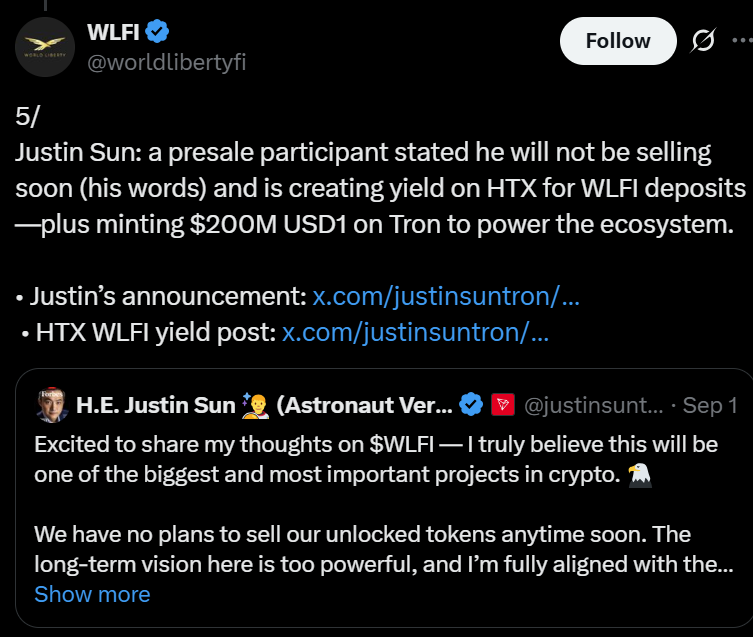WLFI blacklist: Justin Sun’s WLFI token address was flagged and effectively blacklisted after a $9 million transfer to exchange HTX, according to on-chain analytics providers Nansen and Arkham. The flag prompted trading restrictions on the address and coincided with a sharp WLFI price drop during its first week of public trading.
-
Blacklisted after a $9M transfer to HTX
-
On-chain analytics (Nansen, Arkham) flagged the wallet soon after a 50 million WLFI token move.
-
WLFI fell ~22% intraday, trading below $0.18 per CoinMarketCap data.
WLFI blacklist: Justin Sun’s WLFI address was flagged after a $9M transfer to HTX, prompting trading restrictions and a sharp price drop—read full details and data.
What happened when Justin Sun’s WLFI token address was blacklisted?
WLFI blacklist occurred after a 50 million WLFI transfer to exchange HTX that was flagged by on-chain analytics providers. The blacklisting coincided with trading restrictions on the address and a notable sell-pressure event that contributed to WLFI’s rapid price decline in its first week of public trading.
Justin Sun’s WLFI token address was blacklisted after a $9 million transfer on Thursday, raising concerns over trading restrictions as prices tumble.
Tron founder Justin Sun’s World Liberty Financial (WLFI) token address was blacklisted on Thursday after transferring 50 million WLFI tokens to crypto exchange HTX.
On-chain data from Nansen and Arkham shows the address was flagged shortly after a $9 million transaction. The blacklisting fueled concerns that WLFI was subject to address-level trading restrictions, potentially limiting certain users from selling and pressuring market prices during the token’s debut week.
Cointelegraph (plain text mention) reached out to Sun’s team for confirmation but had not received a response by time of publication.
On Thursday, Sun responded to speculation in an X thread, saying in a translated post that his address had only carried out a few routine exchange deposit tests with very small amounts of WLFI tokens before creating address dispersion.
He emphasized that the activity did not involve any buying or selling and “could not possibly have any impact on the market.”

The address restriction followed Sun’s earlier statement that he “will not be selling soon,” signaling alignment with the project’s stated long-term plans.
“We have no plans to sell our unlocked tokens anytime soon,” Sun said. “The long-term vision here is too powerful, and I’m fully aligned with the mission.”
Sun was an early presale participant in the WLFI token.

How did on-chain analytics identify the blacklist and what data supports the claim?
On-chain analytics providers tracked a 50 million WLFI transfer to HTX and flagged the originating address for suspicious or restricted status shortly after a ~$9 million movement. Nansen and Arkham (plain text mentions) reported the flagging based on address behavior and exchange deposit patterns.
Market-data snapshots show WLFI spiked to roughly $0.32 at launch and then fell sharply. By Thursday, the token was down about 22% for the day and trading below $0.18, according to CoinMarketCap (plain text mention).
How did the blacklist affect WLFI trading and prices?
Address-level restrictions can limit which counter-parties can execute sales, reducing available liquidity and increasing downward price pressure. The WLFI blacklisting coincided with a rapid intraday decline, amplifying volatility in the token’s earliest public trading sessions.
Exchange deposit and withdrawal patterns and the timing of Sun’s posted statements help explain market reactions without asserting undisclosed intent.
Summary table: WLFI price action and key events
| Event | Date | Price / Change |
|---|---|---|
| WLFI public launch | Monday (launch week) | Peak ~ $0.32 |
| Flagged wallet transfer to HTX (50M WLFI, ~$9M) | Thursday | Triggered address flagging |
| Intraday decline | Thursday | Down ~22%, trading < $0.18 (CoinMarketCap) |
Frequently Asked Questions
Was Justin Sun’s WLFI address intentionally blacklisted?
On-chain providers flagged the address after a large transfer; Justin Sun has stated the movements were routine deposit tests. Public data confirms the flagging event but does not prove intent to restrict trading.
How can investors verify an address is blacklisted?
Investors can consult on-chain analytics providers and exchange notices for address flags. Look for repeated transfer patterns, exchange deposit behavior, and public statements from projects or exchanges.
Key Takeaways
- WLFI blacklist occurred after a $9M transfer: On-chain analytics flagged a 50M WLFI move to HTX.
- Price impact was immediate: WLFI fell roughly 22% intraday, trading below $0.18 per market data.
- Official statements matter: Justin Sun stated transfers were tests and not market actions; independent on-chain data recorded the flag.
Conclusion
The WLFI blacklist event centered on a flagged 50 million token transfer to HTX and coincided with a significant price drop during WLFI’s first week of trading. On-chain analytics (Nansen, Arkham) and market-data snapshots (CoinMarketCap) provide the factual basis for reporting. Readers should monitor official project updates and exchange notices for further developments.
